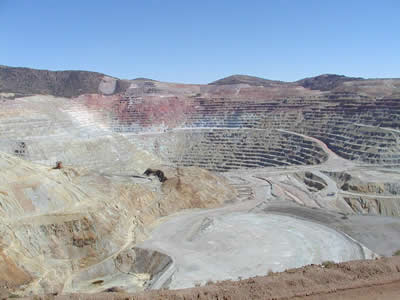
Economic Geology Laboratory
Jump to:
Lab Manager: Dr. Virginia McLemore
Clay Material Testing
The NMBGMR has facilities to characterize the mineralogy and ceramic properties of clay materials. Testing capabilities include particle-size distribution analyses to measure the amounts of clay, silt and coarser material present; X-ray diffraction analyses to determine the mineralogy of both bulk-rock samples and clay-size material; and leaching tests to measure the amount of insoluble material present. The results of these tests aid in determining the value of clay materials to the public and industry, and their importance in scientific research. Recent projects of the clay material testing laboratory include the characterization of mine rock piles and soils contaminated by heavy metals. Another important area of study is the evaluation of clay material resources for existing and possible new industries in New Mexico. Although the clay materials laboratory cannot accept outside samples on a regular basis, contract testing is possible on a limited number of projects in New Mexico in which test results would benefit both the public and the Bureau.
Mineral Separation

Maureen Wilks
Use heavy liquids, water, or other methods to separate heavy minerals. Current projects include separating placer gold samples for detailed characterization and chemical analyses.
Soil and Rock Characterization
Particle size analyses
Particle-size distribution analyses to measure the amounts of clay, silt and coarser material present.
Paste pH and conductivity
Determine the paste pH and paste conductivity of rock and soil samples. Paste tests are used to evaluate the geochemical behavior of mine waste materials subject to weathering under field conditions and to estimate the pH and conductivity of the porewater resulting from dissolution of secondary mineral phases on the surfaces of oxidized rock particles.
Density and specific gravity
Bulk density is the ratio of sample mass to sample volume for a dry sample. Bulk density can be calculated from the particle density (dry mass of all solid particles in a sample divided by the volume of those solid particles) or the specific weight of a dry soil given the sample porosity (or void volume). Bulk density or sample volume are needed to convert gravimetric moisture content to volumetric moisture content.
Deionized water leach
This test is designed to extract soluble sulfates from minerals without attacking insoluble minerals such as silicates, and in particular, clay minerals. It provides an estimate of the soluble minerals, cement, and amorous material in the sample.
Gravimetric Moisture Content
Gravimetric moisture content is used to estimate the moisture content of the material at a specific time [Gardner, 1986; Jury et al., 1991; Hillel, 1998]. If the material’s bulk density is known, then the gravimetric water content can be converted to volumetric moisture content, and thus the material’s in situ matric potential can be determined from a known volumetric moisture content – matric potential relation, also called the Soil-Water Characteristic Curve (SWCC) or moisture retention curve. Observations of in situ matric potential and moisture content values are critical to modeling the seepage and stability of the rock piles
ABA and NAG
Determine the balance between acid producing and acid consuming components of mine waste. It is based on the Sobek Acid Base Accounting (ABA) Procedure.
Determines the net acid remaining, if any, after complete oxidation of waste rock material with hydrogen peroxide and allowing complete reaction of the acid formed with the neutralizing components of the material. The NAG test provides a direct assessment of the potential for a material to produce acid after a period of exposure and weathering and is used to refine the results of the theoretical acid-base accounting (ABA) predictions.
After neutralization is completed, by reaction with hydrogen peroxide, the remaining sulfuric acid (H2SO4), if any, is titrated with sodium hydroxide (NaOH). The amount of NaOH needed is equivalent to the NAG of the material (expressed in kg H2SO4/tonne material).
Slake Durability
ASTM D 4644-87 (Reapproved 1992) Standard Test Method for Slake Durability of Shales and Similar Weak Rocks. The slake durability tests are conducted to estimate the durability and strength of rock samples.
Petrographic Analyses
Petrographic analyses involves optical examinations and mineral identification, which are the basis for all geologic models and characterization, specifically in differentiating various rock units, determining rank and intensity of alteration, determining chemistry of alternating fluids, describing cementation, and determination of paragenesis of mineralization, alteration, and cementation. Alteration rank is based upon the mineral assemblages, which infers temperature, pressure, and permeability conditions at the time of formation.
Semi-quant chemistry (PXRF)
Semi-quantitative chemistry by portable X-ray Fluorescent analyses. PXRF can be used for quick mineral identification.
Updated January 17, 2020


